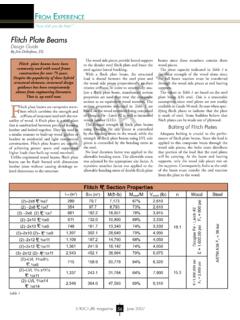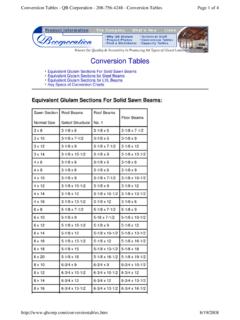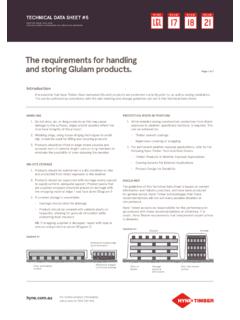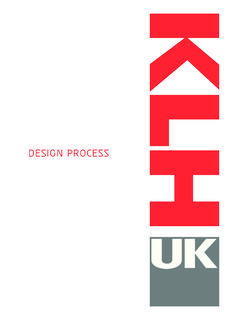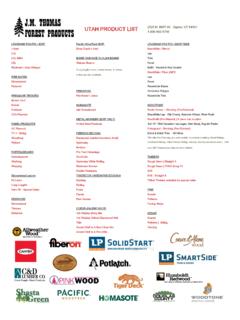Transcription of Specification for Timber Frame Construction
1 TFEC 1-2010 Standard for Design of Timber Frame Structures and Commentary TFEC 1-2010 Standard Page 1 June 2010 TFEC 1-2010 Standard for Design of Timber Frame Structures and Commentary Timber Frame Engineering Council Technical Activities Committee (TFEC-TAC) Tom Nehil Co-Chairman Jim DeStefano Co-Chairman Ben Brungraber Joe Miller Ed Levin Dick Schmidt Funding for development of this standard was provided by the Timber Framers Guild and the Timber Frame Business Council Copyright 2010 Timber Frame Engineering Council PO Box 60 Becket, MA 01223 TFEC 1-2010 Standard Page 2 June 2010 Standard for Design of Timber Frame Structures.
2 3 General Requirements for Structural Design and Construction .. 3 Applicability and 3 Liability .. 3 General Requirements .. 4 Design Loads .. 5 Construction Documents .. 5 Materials .. 6 Notation .. 8 Structural Members .. 10 10 Seasoning Effects .. 10 Notching .. 10 Connections .. 13 13 Withdrawal .. 15 Mortise and Tenon Connections Loaded in Shear .. 15 Mortise and Tenon Connections Loaded in Tension .. 16 Seasoning Effects .. 24 Design for Lateral Loads.
3 25 Stand-Alone Timber Frames .. 25 Timber Frames and Diaphragm - Shear Wall Systems .. 25 Appendix A Glossary .. 27 Appendix B References .. 30 Commentary ..31 TFEC 1-2010 Standard Page 3 June 2010 Standard for Design of Timber Frame Structures General Requirements for Structural Design and Construction Applicability and Scope This Standard defines the engineering and design requirements for Timber Frame Construction . A Timber Frame shall be regarded as a structural building Frame system or a portion thereof that is composed of Timber members in which connections between interlocking members are created by carpenter-style joinery using wood pegs and wood wedges.
4 This Standard is not intended to preclude use of other materials, assemblies, structures or designs not meeting the criteria herein, provided it is demonstrated by analysis based on recognized theory, full scale or prototype loading tests, studies of model analogues or extensive experience in use that the material, assembly, structure or design will perform satisfactorily in its intended end use. This Standard is intended as a supplement to provisions of the National Design Specification for Wood Construction (ANSI/AF&PA NDS , Reference 1). In the event of conflicts or contradictory requirements between this Standard and the NDS , the provisions of the latter Specification shall apply.
5 Liability It is intended that this document be used in conjunction with competent engineering design, accurate fabrication, and adequate supervision of Construction . The Timber Frame Business Council and the Timber Framers Guild do not assume any responsibility for errors or omissions in this document, nor for engineering designs, plans, or Construction prepared from it. Those TFEC 1-2010 Standard Page 4 June 2010 using this Standard assume all liability arising from its use. The design of engineered structures is within the scope of expertise of licensed engineers, architects, or other licensed professionals for applications to a particular structure. General Requirements Strength Buildings and other structures shall be designed and constructed to safely support the anticipated loads that are likely to occur during the lifetime of the structure.
6 In addition, assemblies and subassemblies shall be designed and constructed to safely support those loads that are likely to occur during Construction , including but not limited to Frame assembly and raising. Load types, magnitudes, and combinations shall conform to the building code under which the structure is designed, or where applicable, other recognized minimum design-load standards (see References 4 and 6). Serviceability Structural systems and members thereof shall be designed to have adequate stiffness to limit deflections, lateral drift, vibration, or any other deformations that adversely affect the intended use and performance of the system. Limitations on deflections, lateral drift, vibration, and other deformations shall conform to the provisions of the building code under which the structure is designed.
7 General Structural Integrity Buildings and other structures shall be designed to sustain local damage with the structural system as a whole remaining stable and not damaged to an extent disproportional to the original TFEC 1-2010 Standard Page 5 June 2010 damage location. This shall be accomplished by providing sufficient continuity, redundancy, or energy-dissipating capacity (ductility), or a combination thereof, in the members of the structure. Conformance with Standards The quality of wood products and fasteners and the design of load-supporting members and connections shall conform to the standards specified herein. Design Loads Governed by Codes Minimum design loads shall be in accordance with the local building code under which the structure is designed.
8 In the absence of a local building code, the minimum design loads specified in Minimum Design Loads for Buildings and Other Structures (SEI/ASCE 7; see Reference 4) shall be used. Loads Included Where applicable, design loads shall include any or all of the following loads or forces: dead, live, snow, wind, earthquake, erection and other static and dynamic forces. Construction Documents Types of Documents Construction documents shall be understood to include contracts, plans, specifications, shop drawings and other documents as agreed by the contracting parties intended to convey the Construction requirements for the structure. TFEC 1-2010 Standard Page 6 June 2010 Material Selection The Construction documents shall indicate the species or species group of the Timber as well as the stress grade and grading rules for each structural load-carrying member used in Construction .
9 The Construction documents shall also indicate the species and minimum density of wood used for design of pegs and wedges in the structure. Member Sizes The Construction documents shall indicate whether Timber member sizes are stated in terms of standard nominal dimensions, standard net dimensions, or other designations. Connection Details The Construction documents shall indicate the dimensions necessary for connection fabrication. Locations and sizes of tenons, mortises, housings, and other connection components shall be specified such that fabrication quality can be evaluated. Materials Sawn Timber Design values for solid-sawn timbers used as structural load-carrying members shall be as specified for the species groups and grades defined in the National Design Specification for Wood Construction Supplement, Design Values for Wood Construction .
10 Lumber shall be identified by the grade mark of, or certificate of inspection issued by, a certified grader, a lumber grading or inspection bureau, or an agency recognized by the American Lumber Standards Committee. TFEC 1-2010 Standard Page 7 June 2010 Structural Glued Laminated Timber Design values for structural glued laminated Timber (glulam) shall be as specified for the laminating combination as listed in the NDS Supplement, American Institute of Timber Construction (AITC) Standard Specification AITC 117, or AITC 119 (see References 7 and 8). Glulam shall bear a quality mark from an accredited inspection agency certifying conformance with ANSI/AITC (see Reference 9).



